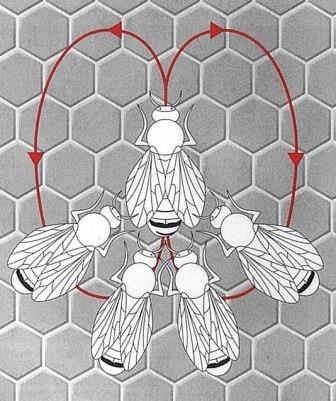The dance language of honeybees (Apis mellifera) is a unique form of animal behavior and communication that was discovered by the zoologist Karl von Frisch (1886–1982) in the 1920s, which he continued to study through the 1960s and for which he was awarded a Nobel Prize in 1973. When foraging worker honeybees return to the hive with pollen or nectar, they perform dance movements to recruit other bees (follower bees) to visit a food source. The specifics of these movements convey information about the distance and direction from the hive to the food. This type of communication is highly unusual: Nonhuman animal communication typically concerns conditions and events immediately surrounding the instigator, whereas the honeybee dance language transmits information about remote events [scientists have documented bee dances about food sources up to 15 kilometers (9.3 miles) away from hives]. See also: Animal communication; Beekeeping; Ethology; Hymenoptera; Pollen; Pollination; Social insects
The bee movements are known as the waggle dance, and they are performed by the female dancer bee on the vertical wax combs found inside the hive. While being observed by a small number of follower bees, the dancer bee moves in a straight line (termed the waggle run) and then circles back, alternating between left and right return paths so that the entire route of the dance takes on a figure-eight shape. During the waggle run, the dancer wags her body from side to side about 13 to 15 times per second and emits sounds (at frequencies of approximately 280 Hz) by vibrating her wings. The angle formed between the direction of the waggle run and the vertical indicates the exact angle that the recruited bees should maintain between their flight path to the food and the direction to the projection of the Sun on the horizon (termed the Sun's azimuth). The distance to the food is indicated by the duration of the waggle run. To further aid the follower bees, the dancer carries the odor of the flowers that were previously visited, enabling the recruits to find the exact food source (no information in the dance itself indicates the shape or color of the flowers). In addition to food sources, bee dance movements can encode information about the locations of water, resin, and suitable new nests. See also: Animal navigation; Physiological ecology (animal); Sun

Animal behaviorists and biologists were initially skeptical of von Frisch's claim that the honeybee dances were sophisticated communications. However, numerous experiments, some involving artificial dancing bees performing in hives, have verified von Frisch's conclusions. These experiments have also demonstrated that the bees observing a dance can obtain its information in complete darkness, which means that vision is not a requirement for the dance communication. Sound vibrations and physical contact between the dancer and follower bees are likely used to transmit the information encoded by the dance. See also: Coevolution between flowering plants and insect pollinators; Colony collapse disorder; Honeybee genome





